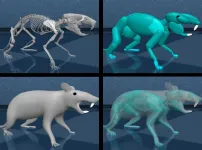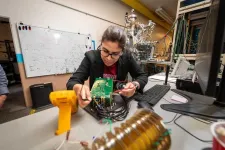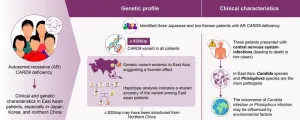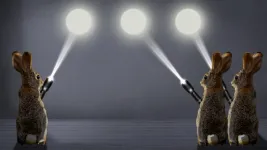(Press-News.org) As long as humans have been traveling into space, astronauts have experienced significant health effects from the extreme conditions of space flight, notably the reduction of gravity.
Two Buck scientists led a team that has revealed for the first time how the lack of gravity affects the cells of the immune system at single cell resolution. As co-senior authors, along with Christopher E. Mason, PhD of Weill Cornell Medical College, Associate Professor David Furman, PhD and Associate Professor Daniel Winer, MD, published in the June 11, 2020 issue of Nature Communications an extensive survey of how gravity affects immune cells, and the identification of “space nutraceuticals” to counter aberrant effects of microgravity on these cells.
“We show how simulated microgravity shapes immune cells and how the changes in force alter the cells’ function at the single cell level,” said Winer. “This level of resolution is new and exciting in understanding the effects of microgravity on cells.”
Using cells in simulated microgravity, combined with data from space flight from astronauts and mice on the International Space Station, the researchers created a complete picture of how the different cells of the immune system in the peripheral blood are shaped by reduced gravity. These cells include lymphocytes and monocytes, which are the main players in immunity.
The study has potential implications for immune aging on Earth since the changes observed during aging resemble those captured during space travel.
The team additionally outlines a pathway for identifying compounds that can reverse the effects of near zero gravity, and demonstrates that one of the compounds, quercetin, shows promise for mitigating the damage caused by spaceflight and during normal aging on the ground.
“Our work provides a resource to better understand how and why the immune system changes in simulated microgravity and spaceflight,” said Furman. “We also provide a way to develop countermeasures to maintain normal immunity under these harsh conditions.”
Astronauts in low earth orbit, such as on the International Space Station, suffer from immune system problems, especially infections, latent viruses reactivating, and skin sensitivity. These reactions occur even on short-term spaceflights.
Previous studies using actual or simulated microgravity conditions have found impaired function of various immune cells. However, the fundamental mechanisms, genes, and pathways that explain immune dysfunction in microgravity were mostly unclear, the researchers said. They wanted to understand what was happening on a cellular level to explain the changes.
The team, led by the study’s co-first authors Buck postdoctoral researcher Fei Wu, PhD and graduate student Huixun Du, examined in depth how 25 hours of simulated microgravity affects the human peripheral blood mononuclear immune system, using samples from 27 healthy human donors between the ages of 20 and 46. To simulate an environment with almost no gravity, the team grew the cells inside of a Rotating Wall Vessel, a device developed by NASA to simulate microgravity conditions.
To explore the changes caused by reduced gravity, the team used a number of techniques, including sequencing and super-resolution microscopy. They then validated their findings by comparing their data with other space studies done in humans and mice, including the JAXA (Cell-Free Epigenome study) mission, SpaceX’s Inspiration 4 mission, NASA’s Twins Study, and spleens from mice housed on the International Space Station.
“Interestingly, changes in mechanical forces appear to orchestrate immune cell function,” said Winer, whose interest in studying space medicine grew from him delving into the emerging field of mechanoimmunology, or how environmental forces affect immune cell function. Parts of astroimmunology are related to mechanoimmunolgy, but it is proving its own as a new field, he said, paving the way to better understand how to help the immune system survive in space.
After unearthing several genes and biochemical pathways that are affected by microgravity, the team wanted to see if they could find any specific drugs or supplements that could protect the immune cells. To help them search, they used machine learning technology developed by Furman at the Buck, which can detect more than 2 million interactions between genes and different drugs and foods.
They identified dozens of potential compounds and chose one, the plant pigment quercetin (often found in red onions, grapes, berries, apples and citrus fruits among others) to explore further since it is widely available as an antioxidant and anti-aging supplement. Quercetin turned out to reverse approximately 70 percent of the changes caused by lack of gravity and protected the cells from reactive oxygen species excess.
“These findings define hallmarks of immune cell alteration in simulated microgravity, with correlation to spaceflight exposures in mice and humans,” said Winer. “This work helps define avenues for future research in mechanoimmunology and astroimmunology and provides opportunities to develop countermeasures to maintain normal cellular function in space.”
Furman adds that this publication sets the standard for how to analyze the physiological changes that accompany space travel. “This is the first comprehensive study that provides the scientific community worldwide with an atlas to understand human biology in this extreme condition,” he says.
“The implications are huge, beyond humans in space,” he adds. The researchers are excited to explore the parallel changes they are finding that occur in aging humans on the ground, and to use the knowledge to design interventions that can potentially reverse the immune dysfunction that accompanies aging.
CITATION: Single Cell Analysis Identifies Conserved Features of Immune Dysfunction in Simulated Microgravity and Spaceflight
https://doi.org/10.1038/s41467-023-42013-y
Other Buck researchers involved in the study include Priya Makhijani, Nicolas Martin, Chad A. Lerner, Khiem Nguyen, Jordan Baechle, Taylor R. Valentino, Matias Fuentealba, Juliet M. Bartleson, Heather Halaweh, Simon Melov, Akos A. Gerencser and Herbert G. Kasler.
Acknowledgements: This work was supported in part through funds derived from the Buck Institute for Research on Aging and the Huiying Memorial Foundation, a T32 NIH fellowship grant (NIA T32 AG000266), the National Institutes of Health (R01MH117406), NASA (NNX14AH50G, NNX17AB26G, 80NSSC22K0254, NNH18ZTT001N-FG2, 80NSSC22K0254, NNX16AO69A), and the Leukemia & Lymphoma Society (MCL7001-18, LLS 9238-16).
COI: Furman is a founder of Edifice Health, a company that utilizes inflammatory biomarkers to predict age-related diseases. Furman, Mason and Winer. are co-founders of Cosmica Biosciences, a company that studies altered biological aging in spaceflight exposures. Baechle and Wu are stakeholders in Cosmica Biosciences. Gerencser has financial interest in Image Analyst Software, which makes the software Image Analyst MKII used for image analysis. The Buck Institute has filed a patent application on using simulated microgravity to mimic and counter aging and spaceflight effects in cells based on data from this manuscript.
About the Buck Institute for Research on Aging
At the Buck, we aim to end the threat of age-related diseases for this and future generations. We bring together the most capable and passionate scientists from a broad range of disciplines to study mechanisms of aging and to identify therapeutics that slow down aging. Our goal is to increase human health span, or the healthy years of life. Located just north of San Francisco, we are globally recognized as the pioneer and leader in efforts to target aging, the number one risk factor for serious diseases including Alzheimer’s, Parkinson’s, cancer, macular degeneration, heart disease, and diabetes. The Buck wants to help people live better longer. Our success will ultimately change healthcare. Learn more at: https://buckinstitute.org
END
Buck researchers explore how the immune system goes awry during space travel and the implications for human aging on earth
Findings provide insight into interventions to maintain normal immunity in space and during aging on the ground
2024-06-11
ELSE PRESS RELEASES FROM THIS DATE:
Social determinants of health linked with youth-onset prediabetes
2024-06-11
Food insecurity, low household income and not having private health insurance are associated with higher rates of prediabetes in adolescents, independent of race and ethnicity, according to a new JAMA Network Open study by University of Pittsburgh and UPMC researchers.
The findings suggest that screening for social determinants of health — the non-medical factors that influence a person's health and risk of disease — may help identify youth at risk of prediabetes, which could ultimately improve early interventions that prevent progression to type 2 diabetes.
“This study underscores the importance ...
Harvard, Google DeepMind researchers create realistic virtual rodent
2024-06-11
The agility with which humans and animals move is an evolutionary marvel that no robot has yet been able to closely emulate. To help probe the mystery of how brains control movement, Harvard neuroscientists have created a virtual rat with an artificial brain that can move around just like a real rodent.
Bence Ölveczky, professor in the Department of Organismic and Evolutionary Biology, led a group of researchers who collaborated with scientists at Google’s DeepMind AI lab to build a biomechanically realistic digital model of a rat. Using high-resolution data recorded from ...
Scientists unlock secrets of how the third form of life makes energy
2024-06-11
Scientists unlock secrets of how the third form of life makes energy.
An international scientific team has redefined our understanding of archaea, a microbial ancestor to humans from two billion years ago, by showing how they use hydrogen gas.
The findings, published today in Cell, explain how these tiny lifeforms make energy by consuming and producing hydrogen. This simple but dependable strategy has allowed them to thrive in some of Earth’s most hostile environments for billions of years.
The paper, led by Monash University Biomedicine Discovery Institute scientists, including ...
Would astronauts’ kidneys survive a roundtrip to Mars?
2024-06-11
The structure and function of the kidneys is altered by space flight, with galactic radiation causing permanent damage that would jeopardise any mission to Mars, according to a new study led by researchers from UCL.
The study, published in Nature Communications, is the largest analysis of kidney health in space flight to date and includes the first health dataset for commercial astronauts. It is published as part of a Nature special collection of papers on space and health.
Researchers have known that space flight causes certain health issues since the 1970s, in the ...
Depressive symptoms may hasten memory decline in older people
2024-06-11
Depressive symptoms are linked to subsequent memory decline in older people, while poorer memory is also linked to an increase in depressive symptoms later on, according to a new study led by researchers at UCL and Brighton and Sussex Medical School.
The study, published in JAMA Network Open, looked at 16 years of longitudinal data from 8,268 adults in England with an average age of 64.
The researchers concluded that depression and memory were closely interrelated, with both seeming to affect each other.
Senior author Dr Dorina Cadar, of the UCL Department of Behavioural Science & Health and Brighton and Sussex Medical School, said: “It is ...
New technique could help build quantum computers of the future
2024-06-11
Quantum computers have the potential to solve complex problems in human health, drug discovery, and artificial intelligence millions of times faster than some of the world’s fastest supercomputers. A network of quantum computers could advance these discoveries even faster. But before that can happen, the computer industry will need a reliable way to string together billions of qubits – or quantum bits – with atomic precision.
Connecting qubits, however, has been challenging for the research community. Some methods form qubits by placing ...
Trash-sorting robot mimics complex human sense of touch
2024-06-11
WASHINGTON, June 11, 2024 – Today’s intelligent robots can accurately recognize many objects through vision and touch. Tactile information, obtained through sensors, along with machine learning algorithms, enables robots to identify objects previously handled.
However, sensing is often confused when presented with objects similar in size and shape, or objects unknown to the robot. Other factors restrictive to robot perception include background noise and the same type of object with different shapes and sizes.
In Applied Physics Reviews, by AIP Publishing, researchers from Tsinghua University worked to break through the difficulties ...
Shedding light on the origin of a genetic variant underlying fungal infections
2024-06-11
Researchers from Japan uncover the genetic diversity and regional patterns of CARD9 deficiency in patients susceptible to fungal diseases
Tokyo, Japan – Fungal infections pose life-threatening risks, especially when vital organs or the central nervous system are affected. Individuals harboring variants in the CARD9 gene are particularly susceptible to invasive fungal infections, given that the protein coded by this gene serves as a critical regulator of the immune system. A recent discovery ...
Humanitarian organizations showed flexibility and grit during COVID supply chain disruptions: study
2024-06-11
When the COVID-19 pandemic hit, it sent shock waves across global supply chains. But manufacturers and other businesses weren’t the only ones hit hard: local and international aid organizations, tasked with providing humanitarian assistance during times of crisis, suddenly had a major crisis of their own. How would they get the supplies they needed to carry out their crucial work?
According to a new study by the UBC Sauder School of Business, the organizations showed remarkable nimbleness and ingenuity — and while the pandemic was an unusual event, their approaches can provide powerful insights ...
Research on the visual rabbit illusion takes a leap forward
2024-06-11
Fukuoka, Japan—Researchers from Kyushu University have uncovered new variations to a traditional illusion, based on how we perceive the motion of flashing lights. Published on May 21 in i-Perception, the findings show that when three light flashes are presented in rapid succession in our side vision, our brain tends to perceive them in a straight line, with the second flash around the midpoint, no matter the actual location of the second flash. This research, which earned the journal’s Early Career Best Paper Prize this year, offers new perspectives on perceptual errors ...
LAST 30 PRESS RELEASES:
Auburn Physics PhD student earns prestigious DOE Fellowship
AI tool helps you learn how autistic communication works
To show LGBTQ+ support, look beyond Pride Month
Using artificial intelligence to understand how emotions are formed
Exposure to wildfire smoke late in pregnancy may raise autism risk in children
Breaking barriers in lymphatic imaging: Rice’s SynthX Center leads up to $18 million effort for ‘unprecedented resolution and safety’
Dhaval Jadav joins the SETI Institute Board to help spearhead novel science and technology approaches in the search for extraterrestrial life
Political writing retains an important and complex role in the national conversation, new book shows
Weill Cornell Medicine receives funding to develop diagnostic toolbox for lymphatic disease
It started with a cat: How 100 years of quantum weirdness powers today’s tech
McGill researchers identify a range of unexpected chemical contaminants in human milk
Physical therapy research highlights arthritis’ toll on the workforce — and the path forward
Biomedical and life science articles by female researchers spend longer under review
Forgetting in infants can be prevented in mice by blocking their brain’s immune cells
Blocking immune cells in the brain can prevent infant forgetting
AI-driven ultrafast spectrometer-on-a-chip: A revolution in real-time sensing
World enters “era of global water bankruptcy”; UN scientists formally define new post-crisis reality for billions
Innovations in spatial imaging could unlock higher wheat yields
A twitch in time? Quantum collapse models hint at tiny time fluctuations
Community water fluoridation not linked to lower birth weight, large US study finds
Stanford University’s Guosong Hong announced as inaugural recipient of the SPIE Biophotonics Discovery’s Impact of the Year Award
Ice, ice, maybe: There’s always a thin layer of water on ice — or is there?
Machine learning lends a helping ‘hand’ to prosthetics
Noninvasive brain scanning could send signals to paralyzed limbs
Community water fluoridation and birth outcomes
SGLT2 inhibitors vs GLP-1 receptor agonists for kidney outcomes in individuals with type 2 diabetes
Long-term exposure to air pollution and risk and prognosis of motor neuron disease
Five-year absolute risk–based and age-based breast cancer screening in the US
Study finds elevated alcohol involvement in suicides of lesbian, gay and bisexual women
Air pollution may increase the risk of the neurodegenerative disease ALS
[Press-News.org] Buck researchers explore how the immune system goes awry during space travel and the implications for human aging on earthFindings provide insight into interventions to maintain normal immunity in space and during aging on the ground





